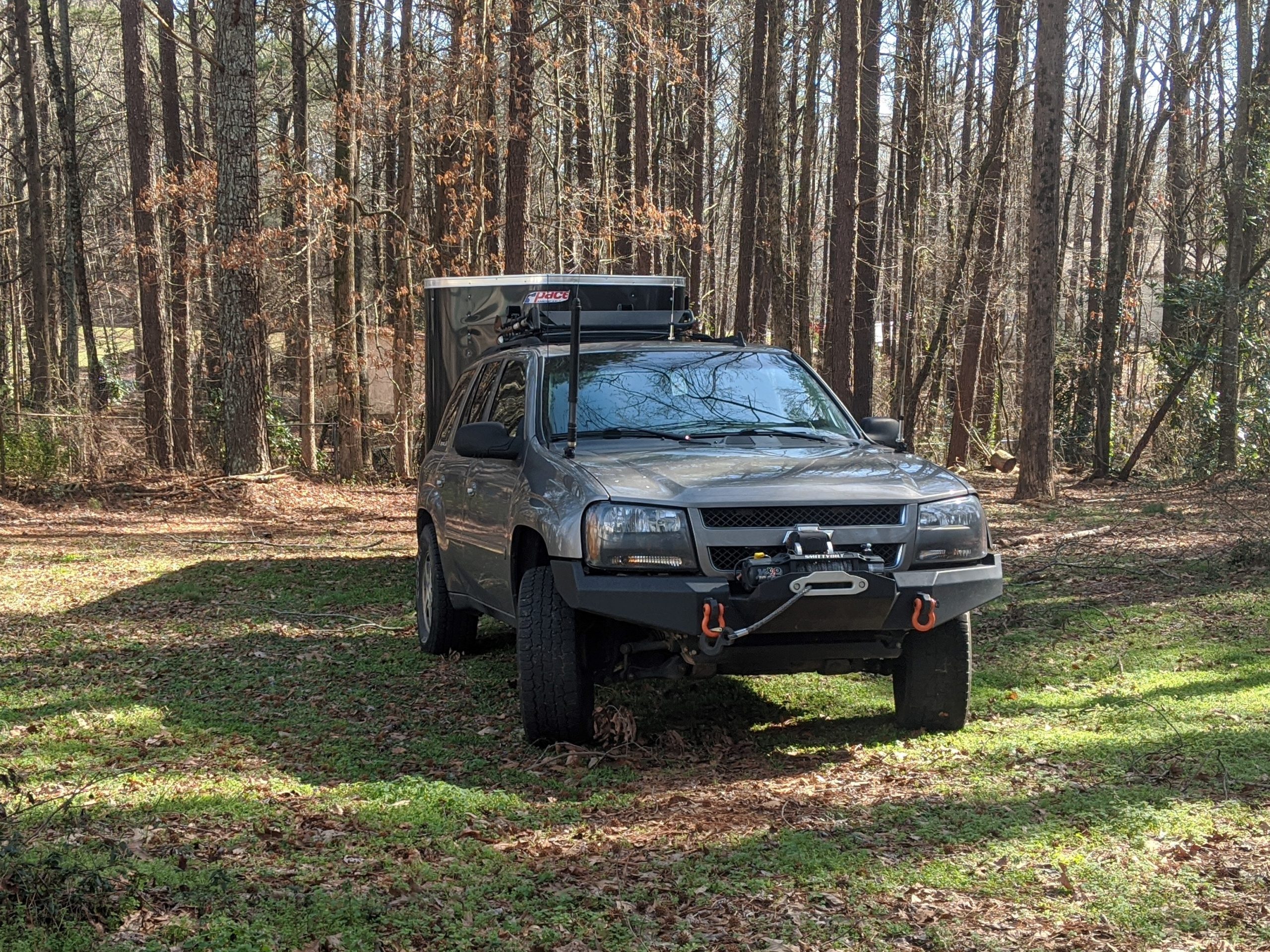
Whether for emergency use or simply to have fun making contacts, using Amateur Radio off-road can be a great option. It can be fun to try to make radio contacts from remote locations and useful to stay in contact with friends or family members. But Amateur Radio can also be useful to have on board in case of emergency situations. Here are some tips and tricks for making the most of utilizing Amateur Radio off-road.
Types of Amateur Radio Equipment to Have Off-Road
The first thing to consider when outfitting an off-road vehicle with Amateur Radio equipment is, “what types of radios should I have?” There are multiple options, each with their own pros and cons. The most common type is analog VHF/UHF, allowing communications with local operators over simplex or through repeaters. There’s also HF for longer distance communications, and APRS for beaconing your current location.
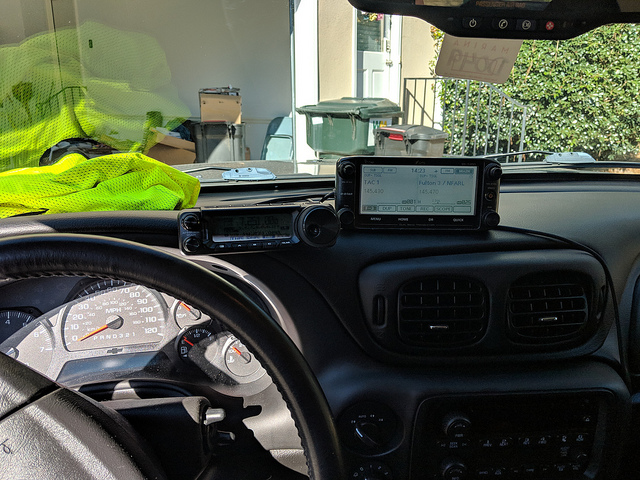
VHF/UHF
The most common radio type to have in a vehicle, whether around town or off-road, is a VHF/UHF radio. These are great for local communications on simplex, or using repeaters for wider-area coverage with great sound quality. When off-road, there might still be one or two repeaters within range of your vehicle. Before leaving, make sure to check a repeater directory or a website such as RepeaterBook and find which repeaters will be closest to your expected area so you can program them in your radio.
However, there is the possibility that you might find yourself in a location with poor repeater coverage. Especially in mountainous terrain with low valleys, you might lose your ability to hit a repeater that you heard crystal-clear at a peak. For this reason, adding an HF radio to your off-road vehicle can be a great idea.
HF
HF radio is great in situations where you are out of cell reception and not within range of a VHF/UHF repeater. Chances are, you’ll be able to contact someone with an HF radio. Mobile HF can be tricky: electrical feedback, engine noise, and alternators can sometimes make HF reception difficult. But when set up properly, an HF radio can be a great tool for off-road communications.
An important thing to keep in mind when using HF, especially when mobile, is band propagation. Some bands perform better than others at various points of the day. Also, some bands are better for local, while others are better for DX. Since my mobile antenna will not cover the 80-meter band, I typically stick with 40-meters when off-road.
Outside of emergency situations, having HF capabilities in an off-road vehicle can be a fun way to pass the time. I personally enjoy trying to see what kind of contacts I can make from my vehicle in remote areas. Logging DX contacts from a campsite using a mobile antenna can be a really fun and challenging activity.
APRS
APRS makes a wonderful addition to an off-road vehicle. If integrated with a GPS, an APRS radio will beacon your position on a dedicated frequency (144.390). This location can then be viewed online, such as on this APRS map. Because APRS is not tied to specific repeaters, but rather picked up by multiple relay stations, there is a chance that your beacons will be relayed if you have a decent enough radio/antenna setup.
Some radios come out of the box with GPS/APRS functionality, or a transmitter can be homebrewed using a GPS receiver and a Raspberry Pi.
APRS is great for beaconing your location in the event of an emergency. If you make a distress call, you can instruct the other operator to find your location on the APRS map, and they’ll be able to pinpoint your location. APRS may also give family members or friends a little peace of mind, as they’ll be able to track your travels on the map.
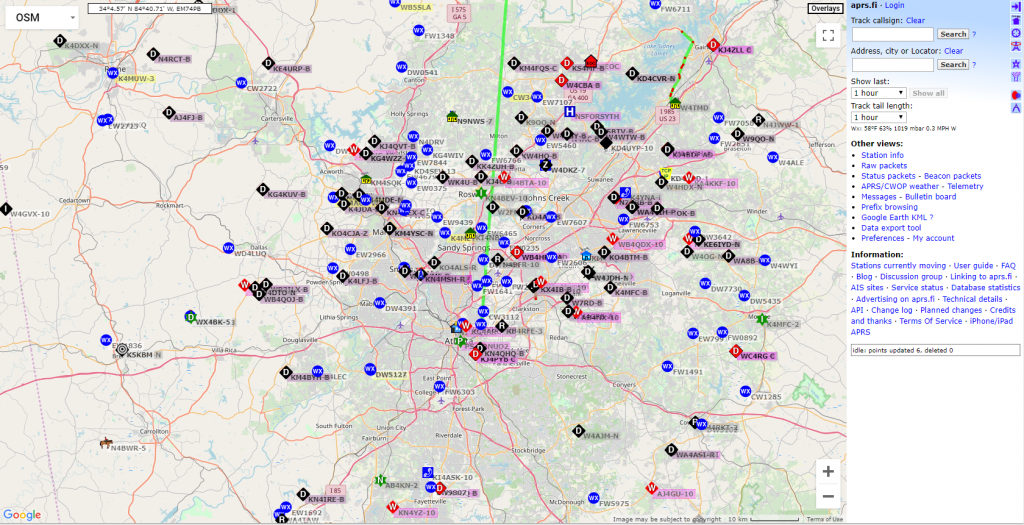
More information about APRS and its many uses can be found on the APRS Wikipedia Page.
Digital
Digital modes such as DMR and D-STAR can be a little trickier off-road. I never expect to travel into a remote area and be within range of a digital mode repeater, but it might be possible. On a handful of occasions, I’ve hit a far away D-STAR repeater while parked at the peak of a mountain ridge.
If you do find yourself within range of a repeater, D-STAR can be a great tool. Some radios, such as the Icom-5100, have built in GPS and will relay your position to the repeater. If the repeater is set up for it, your location will be plotted on the APRS map.
In many areas, DMR repeaters are a lot less common. However, if you’re within range of a repeater or have a DMR hotspot, it can be a fun mode to use. The neat thing about DMR is the different talkgroups that exist for different functions. An important one for off-roaders to make note of is Brandmeister Talkgroup 31655, Venture Overland. This is a talkgroup dedicated to overlanding, off-roading, and outdoor enthusiasts. More information about the Venture Overland talkgroup can be found on their Brandmeister Wiki Page.
Antennas
While there are many mobile antennas on the market, finding a good Amateur Radio antenna for off-road use can be tricky. This is because of the unique considerations that need to be addressed for the type of travel. While a giant HF mobile antenna that extends 10 feet above the vehicle might be great for highway driving, it’s probably not going to cut it when driving on narrow trails with low branches.
Installing antennas on a vehicle for off-road use is a lesson in compromise. You need an antenna that is sturdy and/or small enough to avoid major damage from obstacles such as trees, low tunnels, etc., but you also need an antenna that is efficient and/or large enough to make contact over a long range or through rugged terrain. Of course, there’s always the option of simply disconnecting the antenna on tight trails, and reconnecting later, but I personally enjoy being able to monitor the radios, and this might not be an option for groups off-roading together that need to be in communication with each other.
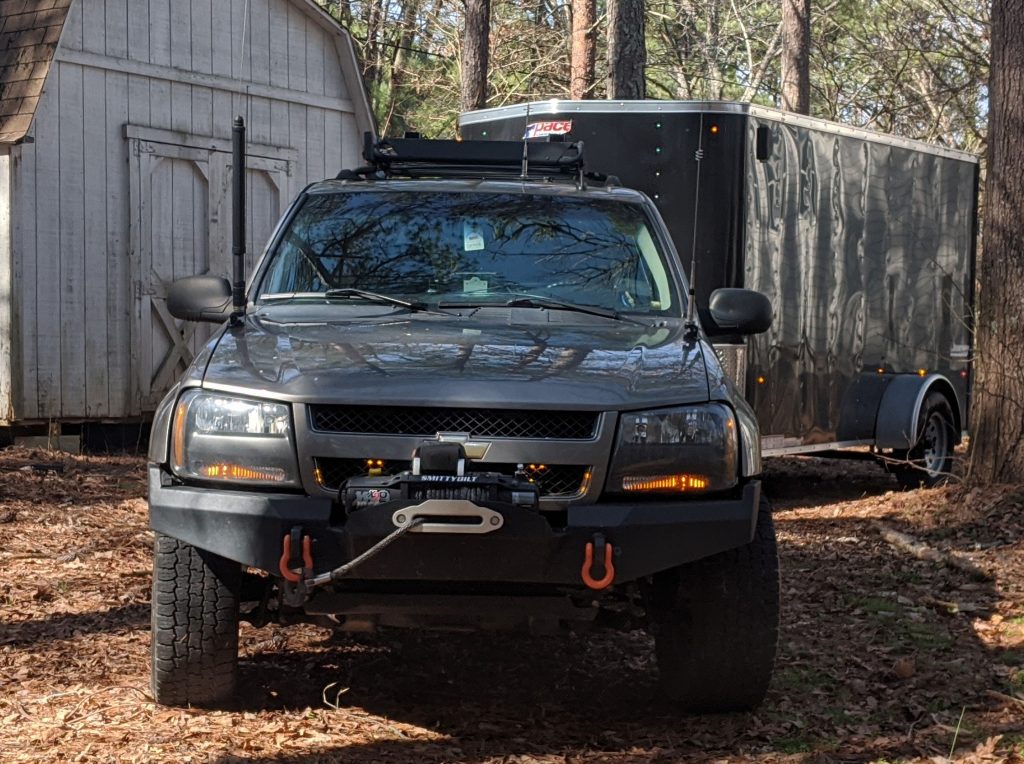
One great tip if you do have a large antenna that you frequently have to take down is to use an NMO connector. NMO antennas are incredibly easy to connect and disconnect on the fly, which can be great when approaching an area that might cause damage to the antenna. Simply disconnect the antenna, place it in your storage area, and reconnect it when you’re parked or in a more suitable environment. I frequently find myself disconnecting and reconnecting my ATAS-120 HF antenna on trails due to its size, and I really wish it had an NMO connector on it!
Important Features to Have in an Off-Road Amateur Radio Setup
There are several important features worth having when implementing Amateur Radio into an off-road vehicle. As discussed above, the ability to beacon GPS location using APRS or D-STAR is great, as this will allow someone to find you in the event of an emergency. Other useful features include crossband repeat and receiving weather alerts.
Crossband Repeat
Crossband Repeat is another feature that may be important if you spend time away from your vehicle, such as when hunting or camping. If your vehicle is within range of a VHF/UHF repeater, you can set it into crossband repeat mode to hit the repeater with your handheld. Without going into too much detail, crossband repeat essentially turns your vehicle into a mobile, miniature repeater. You set your mobile radio to the repeater frequency, and then select an open frequency that is not in use on the other band. Your mobile radio will then forward the audio from the repeater to the other band, which you will be able to hear from your handheld. When you transmit on your handheld, the mobile radio will hear that traffic and repeat it to the input for the distant repeater.
An important thing to note with crossband repeat is that, as the name implies, it’s crossband. if the repeater is VHF, your HT must be able to use UHF. If the repeater is UHF, your HT must be able to use VHF.
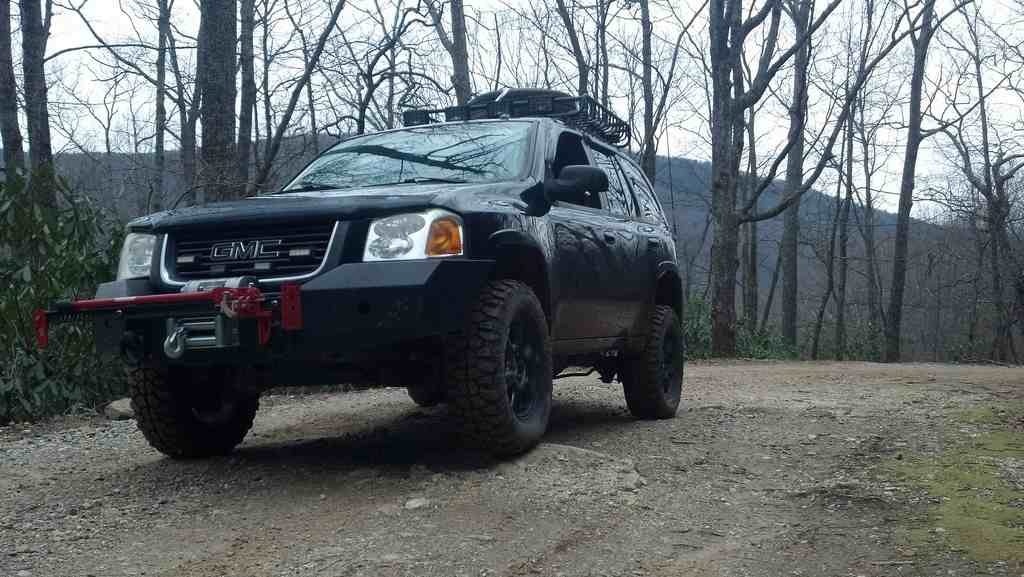
Now about FCC compliance: If you ask ten different Amateur Radio operators, you’ll get ten different opinions about how crossband repeating fits within the FCC guidelines. The regulations state that transmitting stations must follow the identification rules, and repeaters must ID their callsign just like any other operator. When the crossband repeater is transmitting audio from the repeater to the frequency you’re listening on, it’s more than likely not identifying. Some radios, such as the Kenwood TM-V71 include the option to transmit your callsign to meet this requirement, but not all crossband radios do this. I am not a lawyer, and the discussion of FCC compliance is well beyond the scope of this article, but I did want to at least address the potential issue.
Weather Alerts
When off-roading, it is always important to be aware of severe weather moving into the area, but you may not be in a position to simply pull up a radar app on your phone and track the storms. Fortunately, most radios have the ability to pick up the NOAA weather radio stations and often will have a dedicated button or quick menu option to access the frequencies. Most VHF/UHF radios have the ability to monitor a NOAA station in the background for alert tones, and sound an alarm when a severe storm warning is issued.
The weather alert feature works slightly differently on each individual radio model, but the general idea is the same. You select which NOAA station you want to monitor, and then turn on the alert function. The radio will periodically check (roughly every 10 seconds) in the background for an alert tone on that frequency. If your radio detects the alert tone, it will switch your radio to the NOAA frequency. There you will be able to hear the details of the weather warning.
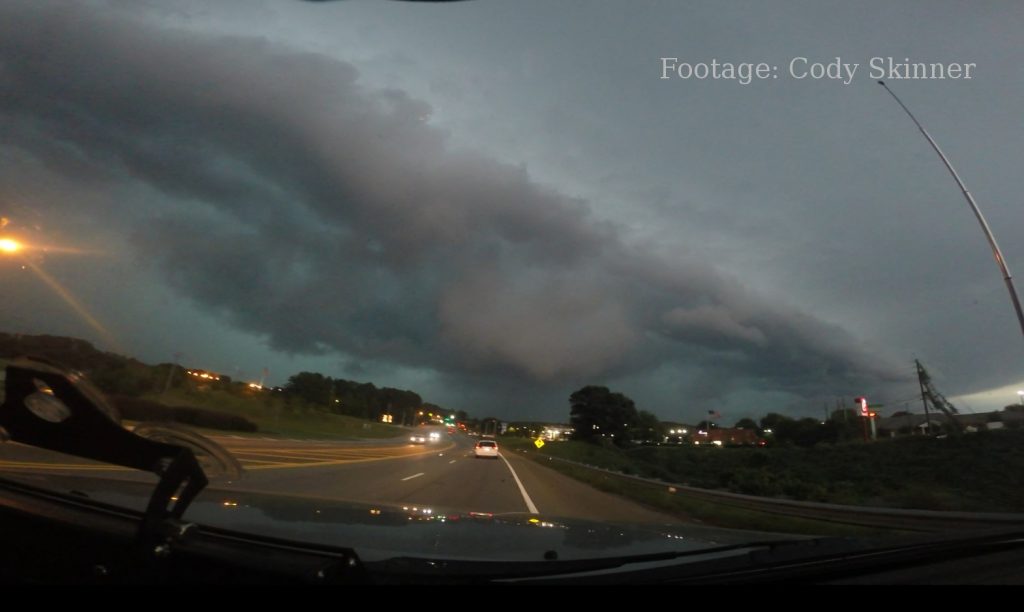
Using Amateur Radio to Get Help Off-Road
If you do find yourself in a situation where you need to call for help, the number one rule is to stay calm. Check and see if you’re within cell-phone reception. If you are, a simple phone call is going to be the most direct and least-complicated option, whether it’s to 911, a family member, or a wrecker service.
If your cellphone is out of reception range, try contacting someone on a nearby repeater. If there is currently a conversation occurring, the appropriate thing to do is to wait for the transmitting station to finish talking, and then key up and say “Break, break” followed by your callsign. I’d recommend doing this quickly, as some operators don’t leave very long gaps in between each other. Once your call is acknowledged, the other operator will usually be able to relay your information for whatever kind of help you need.
If you are out of the coverage area of nearby repeaters, you could try making a simplex call on the national calling frequency: 146.520. Something like: “CQ, Emergency traffic, CQ, Emergency traffic” and then your callsign several times should get a monitoring station’s attention.
Because VHF/UHF is line-of-sight, elevation and terrain matters. If you are able to move your vehicle, you can try relocating somewhere with a higher elevation to make the call.
If you still aren’t able to reach anyone, and you have an HF radio, you can try calling for help on HF. Remember that due to the way propagation works, HF contacts may not be in your immediate area. I usually try 40-meters for more local calls, but would recommend 80-meters if you have the capability. Note that when I say “more local,” I mean that more along the lines of “they might be in the same state.” However, if you can at least make contact with someone, they should be able to relay your information to the right people.
When utilizing Amateur Radio for help in an emergency situation, people are usually willing to go above and beyond to help. However, sometimes things can get complicated with the more people involved. I personally had an experience using Amateur Radio in an emergency situation while off-road, which is detailed in this blog post.
Go Enjoy the Outdoors, Off-Roading, and Amateur Radio
Hopefully this gave you a little bit of an idea of what to consider when deciding to use Amateur Radio off-road. Amateur Radio really can be a great addition to any off-road vehicle, and has a multitude of uses, from entertainment to emergency communications.
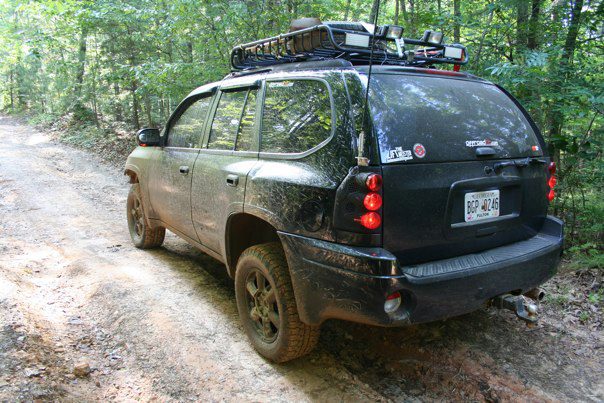
This post is meant to be a general overview of the different uses for radio in an off-road situation. I am planning to continue a segment on this site about Amateur Radio use off-road, and will be making several posts elaborating on some of these sections, detailing equipment installation, and hopefully including some videos. Check back for more!
